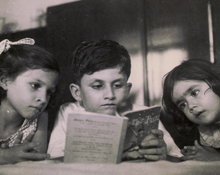Campus News
February 22, 2010
Rushdie archive in paper, pixels

Salman Rushdie (1988)

Note written by Rushdie

Rushdie and his sisters (early 1950s)
Oversized photos of Distinguished Writer-in-Residence Salman Rushdie as a child, a rising young author, and then a celebrity in his own right — hobnobbing with Scarlett Johansson, writing songs for Bono — line the walls of Emory’s Schatten Gallery, but Rushdie’s words, scribbled on sticky notes and reprinted from computer files, remain at the core of the exhibition.
The celebrated author’s archives will open to the public for the first time on Friday, Feb. 26. Like his archives, the companion multimedia exhibit “A World Mapped by Stories: The Salman Rushdie Archive” will be a hybrid, mixing portions of his digital and paper materials throughout.
Emory acquired Rushdie’s archive in 2006. Much of it was traditional paper material: journals, drawings, typed manuscripts, notes scribbled on napkins.
But, like many of his contemporaries, Rushdie — whose fourth novel, “The Satanic Verses,” earned him not only critical acclaim but also death threats from Islamists — wrote his later works and conducted most of the associated correspondence and research on personal computers. Emory’s Manuscript, Archives, and Rare Book Library (MARBL) received not only 100 linear feet of his papers, but also 40,000 files and 18 gigabytes of data on a Mac desktop, three Mac laptops, and an external hard drive.
And, just like that, the University found itself in the forefront of a nascent field: the archiving of “born-digital” materials, with Rushdie’s computers as case study number one. Much of his archival material after the 1980s — including daily calendars, virtual sticky notes, e-mail correspondence, and first drafts of novels — never existed on paper.
“We have darn close to his entire digital life up to 2006,” says Erika Farr ’04PhD, the libraries’ director of born-digital initiatives.
Archivist Laura Carroll, among others at Emory Libraries, has been charged with making this interactive yet carefully preserved digital archive possible. Because Rushdie was highly organized in his virtual realm, he has made her job that much easier.
“He was explicit in file naming and structure,” Carroll says. “I don’t know what I’d have done if he had used just numbers.”
Software engineer Peter Hornsby, who extracted the data from Rushdie’s hard drives, felt it was crucial to emulate the author’s working environment, creating a perfect duplicate that researchers could explore while safeguarding the original: “The imprint of the writer’s personality,” he says, “lies within his computer.”
While other universities have taken possession of digital archives, says Farr, almost none has attempted this full-immersion experience. “We’re going to provide numerous points of access into Rushdie’s digital archive, including emulations of Rushdie’s computers and searchable databases of files pulled off of his computers...”
Selections will be on display in the multimedia exhibit.
“There is a charm and integrity to the more traditional exhibits — a respect for the artifact, the paper,” says exhibition curator and Associate Professor of English Deepika Bahri. “But we wanted a multimedia exhibit that shows a similar respect for the new digital artifact. It’s about honoring what kind of material you now have and its intent. The emerging and the traditional forms coexist; I wanted to break down the hard line between the two.”
Having consulted with Rushdie on the exhibition, Bahri can vouch for him as a fully wired denizen. “Rushdie may not have been born digital, but he has been reborn digital,” she says.
Arriving for his campus residency this week, Rushdie has proven very interested in how his archives will be presented. University librarians, archivists, and legal experts have worked with him every step of the way to determine what can be released and what must be kept confidential — and for how long.
As far as Rushdie’s archives, says Lisa Macklin, coordinator of the libraries’ intellectual property rights office, “we have an agreement with him, which we’ve revised as time goes on…Who among us knows what’s on their hard drive? We have to find a balance between protecting his privacy and providing significant content to researchers who would find value from it.”
